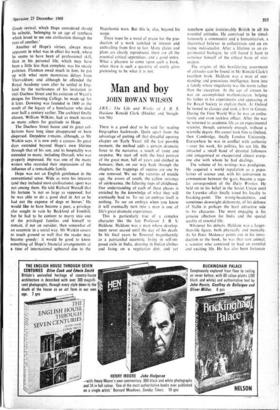Thomas Hope and the Neo-Classical Idea David Watkin (Murray 63s)
Patient hope
OLIVER WARNER
Old-style patronage could have odd effects, among them cross-fertilisation. This is strik- ingly exemplified in the influence of Thomas Hope, who has now become the subject of a really full and distinguished study. Hope was an Amsterdam banker of Scots descent, whose first language was French, though he wrote English admirably, indeed better than he seems to have spoken it. Among, his many achievements was the creation of -a hero for Denmark: on an early visit to Rome he came upon the work of Bertel Thorvaldsen, the sculptor son of an. Icelandic wood-carver, saw its merit, and set the artist on his way to becoming a Danish institution. The. museum which Thorvaldsen founded at Copenhagen, regarded with varying degrees of curiosity -by later - generations, remains a quarry for the student of neo-classicism.
The life of such a man as .Hope is worth 'study because, while works of art live on in -their own right, granted the necessary vitality, it is often the fate of the patron-virtuoso to be overlooked by posterity. For instance, shortly before Hope's heyday, Sir William Hamilton was one of the most- energetic and enlightened patrons in Europe, yet today only specialists remember this. To others he is just the old man who was cuckolded by Nelson. Hope and Hamilton had a strong connection, for it was Hope who bought Hamilton's second collection of classical vases, or rather what was left of them when the ship in which he had sent them home from Naples, which was wrecked off the Isles of Scilly, could be given the attention of salvage.
Hope was even more creative in his own right than Hamilton, and he had a much longer purse. He bought a house in Duchess Street which had belonged to Hamilton's sister, turned it into a lived-in museum, and did much the same at Deepdene, near Dorking, where he illustrated the idea of the Picturesque on an extensive scale. He designed and he expounded, and he figures in works of reference as the author of a book, Anastasius: or Memoirs of a Modern•Greek, which made such an impression when it appeared anonymously in 1819" that it was attributed to Byron. The
poet's reaction -was flattering. He told Lady
Blessington that he wept bitterly, first that he had not written it, and then because Hope had. Mr Watkin, with the equipment of scholar- ship, shows Hope's immense influence on taste at large, most of all in furthering that neo- classicism which in the nineteenth century produced many buildings and appropriate fur-
nishings. After, a brief biographical chapter, tantalising, since he makes the reader want to know much more, Mr Watkin plunies straight into detail and technicalities concerning the
Greek °revival, which Hope considered should be eclectic, 'belonging to an age of synthesis which loved to see one civilisation through the eyes of another.'
Another of Hope's virtues, always more apparent in what was in effect his work, where be seems to have been of professional skill, than in his personal life, which may have been a little less than complete, was his steady patience. Flaxman owed much to him; he put up with what seem monstrous delays from Thorvaldsen; and although he offended the Royal Academy soon after he settled in Eng- land by the tactlessness of his invitation to visit Duchess Street and his criticism of Wyatt's designs for Downing College, he made up for it later. Downing was founded in 1800 as the result of the legacy of a benefactor who died over half a century earlier. The architect finally chosen, William Wilkins,. bad as much reason as many others for gratitude to Hope.
The Duchess Street house and its great col- lections have long since disappeared or been -dispersed. Deepdene re-mains, although, as Mr Watkin says, it is now only a carcass. Its great days extended beyond Hope's own lifetime through that of his son, and its hospitality was extended to many, including Disraeli, who was properly impressed. He was one of the many writers who recorded their impressions of the influence of a remarkable family.
Hope was not an English gentleman in the conventional sense. Wide as were his interests (and they included most civilisations), sport was not among them. He told Richard Westall that his fortune 'is not so large as supposed, but he was able to do a good deal in Art as he had not the expense of dogs or horses.' He would like to have become a peer, a privilege also sought in vain by Beckford of Fonthill, but he had to be content to marry into one of the privileged families and himself to remain, if not an outsider, then somewhat of an eccentric in a social way. Mr Watkin covers so much ground so well that the reader may become greedy: it would be good to know something of Hope's financial arrangements at a time of international upheaval due to the Napoleonic wars. But this is, alas, beyond his scope.
There must be a word of praise for the pro- duction of a work ramified in interest and enthralling from first to last. Many plates and plans are clearly reproduced, there are all the essential critical appendices, and a good index. What a pleasure to come upon such a book, when there is such a quantity of costly gloss pretending to be what it is not.



































 Previous page
Previous page